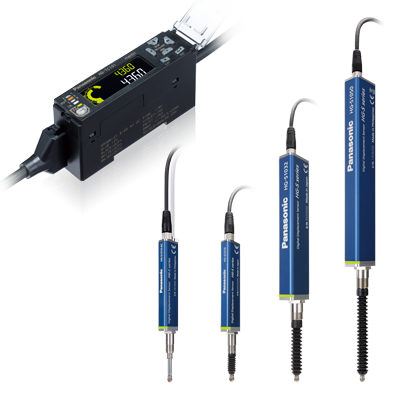Measuring the dimensions of a snap-fit mechanism
Measuring the dimensions of a snap-fit mechanism
When snap-fit mechanisms for supporting parts on a resin plate are improperly shaped, their tips can break off (resulting in a short shot). You wish to detect defects by measuring the dimensions of the snap-fit mechanism (angle and height) (Required precision: ±20 μm)
[Issue] Variability in the resin surface
Unless an expensive model is used, contactless sensors don’t yield stable readings due to the effects of variability of the resin surface (due to variations in luster and minuscule bumps and crevices on the surface).

[Solution] Use an HG-S Series Contact-type Digital Displacement Sensor to measure the angle and height of snap-fit mechanisms on the resin plate.
Use an HG-S Series Contact-type Digital Displacement Sensor to reliably detect the edges of the snap-fit mechanisms and measure their height.

Contact type
The contact-type sensor can make measurements without being affected by surface luster or contaminants like oil.
Roller-type probe and bending-resistant cable
By using a roller-type probe and bending-resistant cable, the sensor is able to make measurements while the head is moved and thereby trace the shape of the snap-fit mechanism.

Key considerations in choosing a sensor

High-precision measurement
With resolution of 0.1 μm 0.004 mil and indication precision of 1.0 μm or less across all ranges, the sensor delivers high-precision measurement!
(When using the HG-S1110□ high-precision sensor head)
Stable detection
Since the sensor is a contact-type device, it’s capable of stable measurement without being affected by the condition of the surface, for example in terms of color, luster, or roughness!
Related information
Related articles
-
Testing the bottoms of metal cans to verify that they’re securely fitted
Measuring the height of the bottoms of metal cans
-
Testing installation of automotive roof rails
Testing the tightening height of installation screws on automotive roof rails
-
Testing for distortion in die-cast parts
Measuring distortion in die-cast parts with a contact-type sensor
-
Measuring the thickness of urethane foam sheet
Measuring thickness in order to maintain uniform urethane foam sheet thickness
-
Detecting the edge of film
Detecting location in a process that layers film
-
Measuring misalignment of rolled metal sheets
Detecting overlapping metal speaker parts (center caps)
-
Measuring the height of a desiccant-coated surface (on circuit boards)
Measuring the height of a desiccant-coated surface (on circuit boards)
-
Measuring the thickness of metal parts (speaker center caps)
Detecting overlapping metal speaker parts (center caps)







